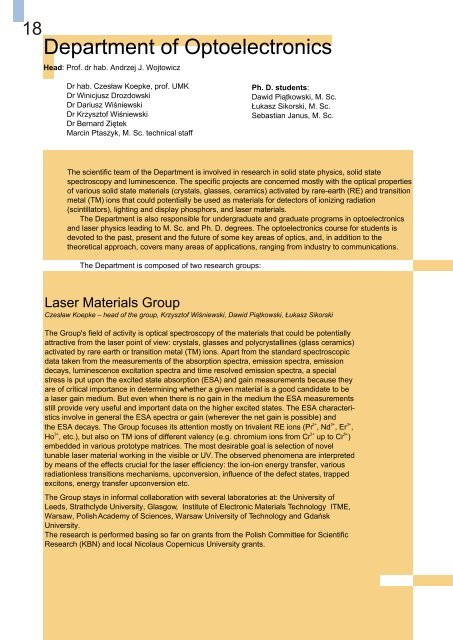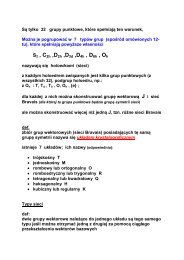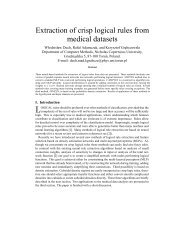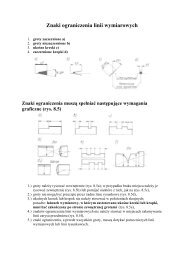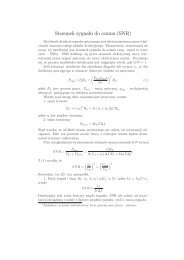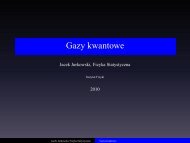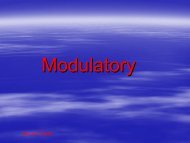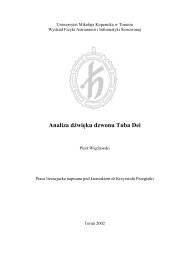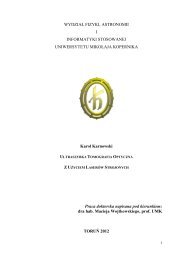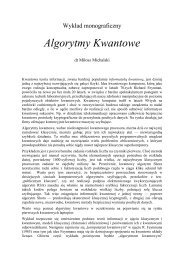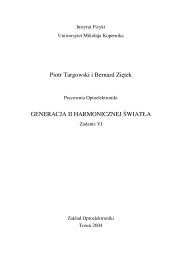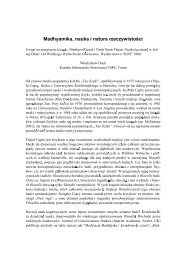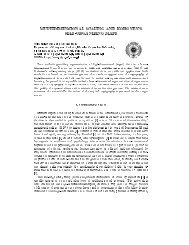Physics at Nicolaus Copernicus University
Physics at Nicolaus Copernicus University
Physics at Nicolaus Copernicus University
You also want an ePaper? Increase the reach of your titles
YUMPU automatically turns print PDFs into web optimized ePapers that Google loves.
18<br />
Department of Optoelectronics<br />
Head: Prof. dr hab. Andrzej J. Wojtowicz<br />
Dr hab. Czes³aw Koepke, prof. UMK<br />
Dr Winicjusz Drozdowski<br />
Dr Dariusz Wiœniewski<br />
Dr Krzysztof Wiœniewski<br />
Dr Bernard Ziêtek<br />
Marcin Ptaszyk, M. Sc. technical staff<br />
The scientific team of the Department is involved in research in solid st<strong>at</strong>e physics, solid st<strong>at</strong>e<br />
spectroscopy and luminescence. The specific projects are concerned mostly with the optical properties<br />
of various solid st<strong>at</strong>e m<strong>at</strong>erials (crystals, glasses, ceramics) activ<strong>at</strong>ed by rare-earth (RE) and transition<br />
metal (TM) ions th<strong>at</strong> could potentially be used as m<strong>at</strong>erials for detectors of ionizing radi<strong>at</strong>ion<br />
(scintill<strong>at</strong>ors), lighting and display phosphors, and laser m<strong>at</strong>erials.<br />
The Department is also responsible for undergradu<strong>at</strong>e and gradu<strong>at</strong>e programs in optoelectronics<br />
and laser physics leading to M. Sc. and Ph. D. degrees. The optoelectronics course for students is<br />
devoted to the past, present and the future of some key areas of optics, and, in addition to the<br />
theoretical approach, covers many areas of applic<strong>at</strong>ions, ranging from industry to communic<strong>at</strong>ions.<br />
The Department is composed of two research groups:<br />
Laser M<strong>at</strong>erials Group<br />
Ph. D. students:<br />
Dawid Pi¹tkowski, M. Sc.<br />
£ukasz Sikorski, M. Sc.<br />
Sebastian Janus, M. Sc.<br />
Czes³aw Koepke – head of the group, Krzysztof Wiœniewski, Dawid Pi¹tkowski, £ukasz Sikorski<br />
The Group's field of activity is optical spectroscopy of the m<strong>at</strong>erials th<strong>at</strong> could be potentially<br />
<strong>at</strong>tractive from the laser point of view: crystals, glasses and polycrystallines (glass ceramics)<br />
activ<strong>at</strong>ed by rare earth or transition metal (TM) ions. Apart from the standard spectroscopic<br />
d<strong>at</strong>a taken from the measurements of the absorption spectra, emission spectra, emission<br />
decays, luminescence excit<strong>at</strong>ion spectra and time resolved emission spectra, a special<br />
stress is put upon the excited st<strong>at</strong>e absorption (ESA) and gain measurements because they<br />
are of critical importance in determining whether a given m<strong>at</strong>erial is a good candid<strong>at</strong>e to be<br />
a laser gain medium. But even when there is no gain in the medium the ESA measurements<br />
still provide very useful and important d<strong>at</strong>a on the higher excited st<strong>at</strong>es. The ESA characteristics<br />
involve in general the ESA spectra or gain (wherever the net gain is possible) and<br />
3+ 3+ 3+<br />
the ESA decays. The Group focuses its <strong>at</strong>tention mostly on trivalent RE ions (Pr , Nd , Er ,<br />
3+ 3+ 6+<br />
Ho , etc.), but also on TM ions of different valency (e.g. chromium ions from Cr up to Cr )<br />
embedded in various prototype m<strong>at</strong>rices. The most desirable goal is selection of novel<br />
tunable laser m<strong>at</strong>erial working in the visible or UV. The observed phenomena are interpreted<br />
by means of the effects crucial for the laser efficiency: the ion-ion energy transfer, various<br />
radi<strong>at</strong>ionless transitions mechanisms, upconversion, influence of the defect st<strong>at</strong>es, trapped<br />
excitons, energy transfer upconversion etc.<br />
The Group stays in informal collabor<strong>at</strong>ion with several labor<strong>at</strong>ories <strong>at</strong>: the <strong>University</strong> of<br />
Leeds, Str<strong>at</strong>hclyde <strong>University</strong>, Glasgow, Institute of Electronic M<strong>at</strong>erials Technology ITME,<br />
Warsaw, Polish Academy of Sciences, Warsaw <strong>University</strong> of Technology and Gdañsk<br />
<strong>University</strong>.<br />
The research is performed basing so far on grants from the Polish Committee for Scientific<br />
Research (KBN) and local <strong>Nicolaus</strong> <strong>Copernicus</strong> <strong>University</strong> grants.


